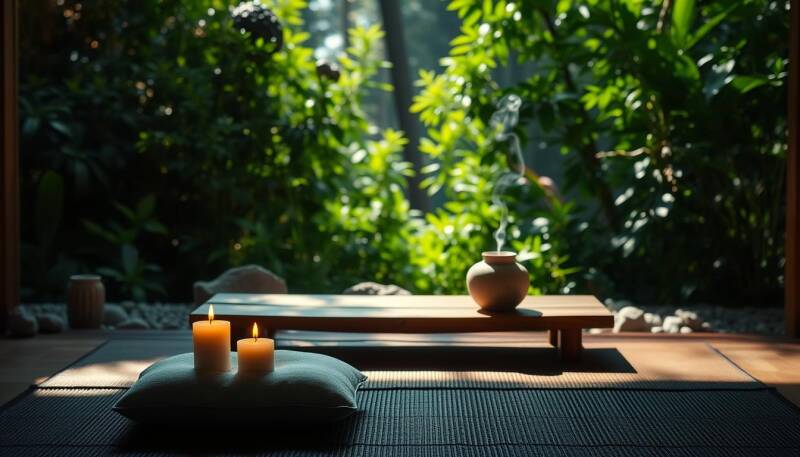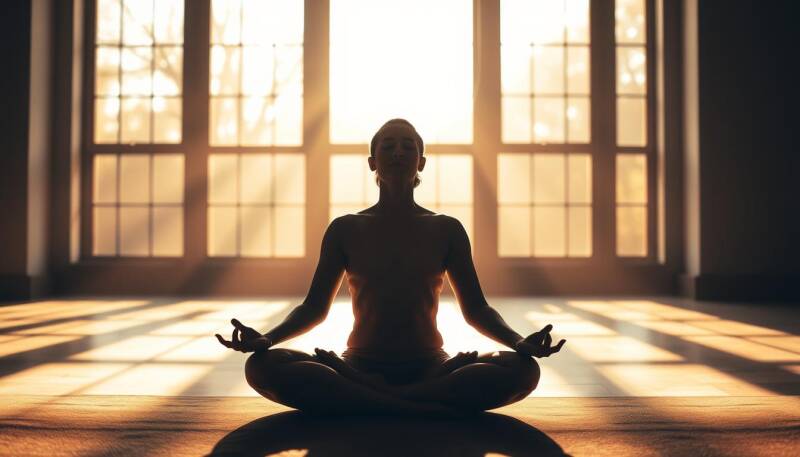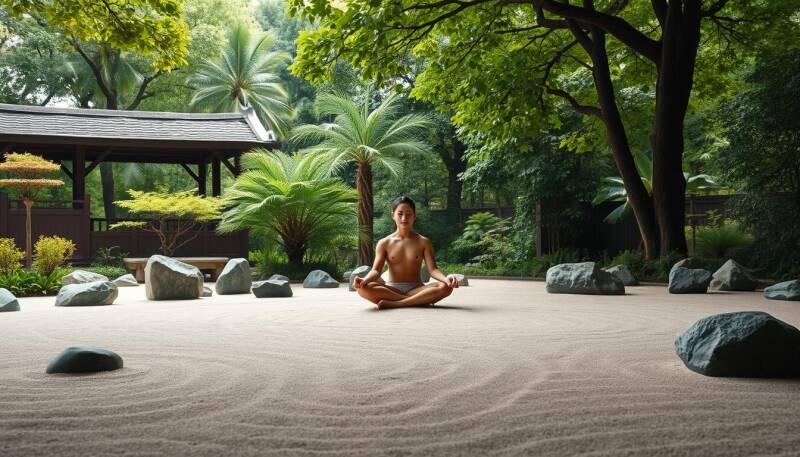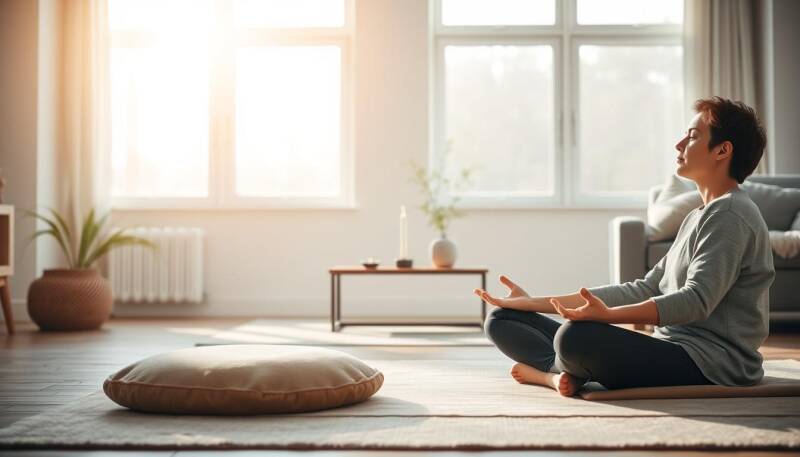Life in a connected world moves fast. Constant pings and tasks can fracture focus and raise stress.
Small, intentional moments woven into your time offer a practical way back to calm. These short practices work with the brain’s natural rhythms, not against them.
Start with morning centering — feet flat, three deep breaths, and a simple intention. Add a personal mantra and a mindful bite at breakfast. Midday pauses and a one‑minute gratitude check lower tension.
In the evening, jot three wins, set one clear focus for tomorrow, and try a brief body scan. Turning chores like cooking into moving meditation builds steady presence in daily life.
This guide offers friendly, realistic steps that fit a busy schedule. Expect tiny shifts in attention that bring more clarity and less stress so you can live your values, one small habit at a time.

Key Takeaways
- Short, simple practices reduce stress without long meditation sessions.
- Morning, midday, and evening moments form an easy journey through the day.
- Micro‑breaks and breath work sharpen focus and calm the mind.
- Everyday tasks can become mindful moves that anchor presence.
- Progress matters more than perfect silence—gentle consistency wins.
Set the tone: why small daily rituals bring calm in a hyper-connected world
In an always-on world, tiny habits act like anchors that steady attention and calm the nervous system.
Brief, repeatable rituals reduce cognitive overload by creating micro-transitions that separate tasks and lower stress. A simple 30-second reset—close your eyes, roll your shoulders, and take three deliberate breaths—lets the brain mark a clean switch and resets your tone.
Eating lunch away from your workspace changes environmental cues and can cut afternoon stress. A one-minute gratitude check—name three small positives in your immediate experience—shifts chemistry toward appreciation and more peace.
- Anchor focus: Tiny pauses restore clarity and protect attention in a busy life.
- Protect transitions: Space between things prevents task-blending and decision fatigue.
- Mini practice: Short, kind exercises are fast to learn and easy to keep.
Start with one or two simple moves and watch how small pauses change your day, steady your mind, and create lasting gains in focus and calm.
Daily Rituals for Inner Peace - 7 Zen Practices to Transform Your Day
A few intentional minutes in the morning can shape how your mind meets every task ahead.
Begin with a 3-minute morning centering
Place your feet firmly on the floor, take three deep breaths, and set a single clear intention. This 3-minute centering builds a gentle buffer between sleep and the day.
Create a simple morning mantra
Repeat a short phrase like "I create calm wherever I go" while brushing your teeth or showering. The mantra gives your mind a steady anchor during small moments.

Make breakfast mindful
Turn breakfast into one focused task. Remove screens and notice flavors and textures. This single-task practice trains presence and reduces stress before work begins.
Use quick resets through the day
Between tasks, try a 30-second reset: close your eyes, roll your shoulders, and take three deliberate breaths. Eat lunch away from your desk to change space and restore mental energy.
Afternoon gratitude and evening wind-down
Take a one-minute gratitude moment and name three specifics you appreciate right now. In the evening, write three wins and one focus for tomorrow, start a tech sunset, and do a 60-second body scan to ease tension and support sleep.
| Moment | Action | Time | Benefit |
|---|---|---|---|
| Morning | Feet grounded + three breaths + intention | 3 minutes | Calmer start; clearer focus |
| Midday | 30-second reset between tasks | 30 seconds | Reduces micro-tension; sharper work |
| Afternoon | One-minute gratitude list | 1 minute | Shifts stress into appreciation |
| Evening | Day note + tech sunset + 60-second body scan | 5 minutes | Releases tension; supports sleep |
Integrating Zen principles into everyday life: simplicity, presence, and intention
A modest shift — doing one thing slowly — brings steady clarity to busy life.
Apply issoku by focusing on a single task at a time at work, home, or during meals. This practice keeps the mind in the present moment and cuts stress. Finish each task before moving on so mental clutter drops and clarity improves.

Put space between things
Build short buffers between activities. Even thirty seconds of quiet breathing helps the brain reset.
Protected transitions preserve energy and make it easier to return to focus. Use these pauses as a simple cue to be present.
Designate time and make chores mindful
Block specific hours for email, meetings, and deep work. Fewer context switches mean less stress and more peace.
Turn cleaning and cooking into moving meditation by noticing motions, textures, sounds, and scents. This way of working brings calm and steady clarity to daily life.
- Do less, better: choose one way to simplify your day and stick with it.
- Breathe before tasks: a brief moment anchors attention and signals the mind to arrive.
Build supportive micro-rituals at home and work for sustained inner peace
Create small anchors at home and work that quietly steady energy and help you stay calm through the day. These simple moves ask for little time but return calm and clearer focus when stress rises.

Wake up early and slowly
Wake a bit earlier and spend a few minutes breathing before you open any screens. Let the body settle with slow breath and gentle stretches or short yoga to welcome steady energy.
Chant or repeat a mantra
Try a light chanting or silent mantra each morning. This trains positive self-talk and, when shared in a group, builds a warm sense of community and shared calm.
Create a mini dry garden
Place a small karesansui kit on your desk or shelf. A few minutes raking concentric patterns clears the mind and refocuses your sense of attention.
- Mindful meals: Sit, chew slowly, and notice taste—this preserves energy without extra time.
- Space cues: Keep a bell, plant, or candle near work to mark transitions and reduce stress.
- Repeatable routine: Choose one morning and one work ritual you will keep each day.
From morning routine to evening ease: a simple day plan you can start today
Map a simple day plan that moves you from a clear morning start into a calm evening close.

Morning
Begin with a 3-minute centering: feet grounded, three deep breaths, and one clear intention to start day with a calm tone.
Repeat a short mantra while you prepare and have a single-task breakfast to align mind and body.
Midday
Use 30-second resets between work blocks: close your eyes, roll your shoulders, and take three deliberate breaths.
Step into a different space for lunch and take a one-minute gratitude pause to refresh energy and focus.
Evening
Close the loop by jotting three wins and one focus for tomorrow. Begin a tech sunset to dim input before sleep.
Finish with a 60-second body scan from toes to head to release tension and prime restful sleep.
- Slot time: add these short practices to your calendar so they actually happen.
- Protect blocks: set boundaries for email and deep work to preserve attention and recovery space.
- One cue: place a bell or plant as a simple marker for transitions through your life and work.
| Phase | Key Action | Length | Primary Benefit |
|---|---|---|---|
| Morning | 3-minute centering + mantra + mindful breakfast | 3–10 minutes | Sets calm tone; aligns mind and body |
| Midday | 30-second resets + different-space lunch + gratitude | ~2 minutes (spread) | Restores clarity and energy |
| Evening | Three wins + tech sunset + 60-second body scan | 5–10 minutes | Releases tension; improves sleep |
Conclusion
A simple set of short moves can shift energy and help you meet the day with more calm.
Start with one morning ritual, one midday reset, and one evening close. These small choices free mental space and lower stress without long meditation sessions.
Use a single breath and a brief phrase when thoughts race. Let chores become moving meditation and place a small cue at home—like a yoga mat or a mini dry garden—to remind you to pause.
Keep it light and steady: refine what works, drop what doesn’t, and give yourself time. Small steps practiced each time build lasting clarity, calmer mind, and better sleep.
FAQ
What are quick morning centering steps I can actually stick to?
Start with feet flat on the floor, soften your shoulders, and take three slow, deep breaths. Set a clear, simple intention like “I choose calm.” Keep it to three minutes so it’s doable every day, even before a busy morning.
How do I create a morning mantra that feels authentic?
Pick a short phrase that matches your values and repeat it aloud or silently for one minute. Examples: “I create calm wherever I go” or “I meet the day with ease.” Keep language positive and present tense for the best effect.
What does a mindful breakfast look like in practice?
Make your meal a single-task moment: sit down, turn off screens, notice textures, flavors, and breath between bites. Aim for five to ten focused minutes to train attention and reduce morning stress.
How can I reset my mind in 30 seconds during work?
Pause, close your eyes, roll your shoulders, and take three counted breaths. Stretch your neck and let the jaw unclench. That small break helps clear tension and restores focus for the next task.
Why is stepping away at lunch important for energy?
Changing your physical space signals your brain to shift gears. A short walk or eating outside boosts circulation, breaks screen fatigue, and replenishes mental energy for the afternoon.
What is a gratitude minute and how does it change stress?
Spend 60 seconds listing one to three things you appreciate—big or small. This practice shifts brain chemistry from stress to appreciation, lowering cortisol and increasing resilience.
How do I end the day to improve sleep quality?
Do a quick day-completion note: jot one win and one thing to let go of. Put devices on a tech sunset, then do a 60-second body scan from head to toe to release tension before bed.
What does “do one thing at a time” look like for busy schedules?
Designate short blocks for focused work, email, and breaks. Turn off notifications during those blocks and commit to only that activity. Small, consistent single-tasking builds clarity and reduces overwhelm.
How can I protect transitions between tasks to maintain clarity?
Build micro-spaces: five breaths, a short stretch, or standing to drink water between activities. These pauses create mental boundaries so one task doesn’t bleed into the next.
Can household chores be calming rather than stressful?
Yes. Treat cleaning or cooking as moving meditation. Focus on the rhythm, smells, and sensations. Slow down and notice the details—this transforms routine work into mindful practice.
How early should I wake up to practice these micro-habits?
You don’t need a drastic change. Wake 10–20 minutes earlier to breathe, set an intention, and have a mindful bite. Small shifts are more sustainable than full schedule overhauls.
Is chanting or repeating a mantra suitable for everyone?
Yes—if it fits your beliefs. Silent repetition works well for most people. In group settings, chanting can build connection; alone, it helps rewire thought patterns toward calm.
What is a mini dry garden and how does it help focus?
A mini karesansui is a small tabletop arrangement of sand, stones, and maybe a tiny rake. Spend a minute tending patterns to train gentle, focused attention and invite visual calm into your space.
How do I combine morning, midday, and evening habits into a simple plan?
Keep a short, repeatable structure: Morning—intention, mantra, mindful breakfast. Midday—30-second reset and mindful lunch. Evening—closure note, tech sunset, body scan. Start small and adjust to fit your life.
Taking a few mindful minutes each day gently transforms how you move through your inner world. Start small, stay consistent, and let calm become your new default rhythm.
🌟 Want more Zen rituals?
Download your free guides and deepen your inner peace journey.
Get My Free Guides

Ajouter un commentaire
Commentaires